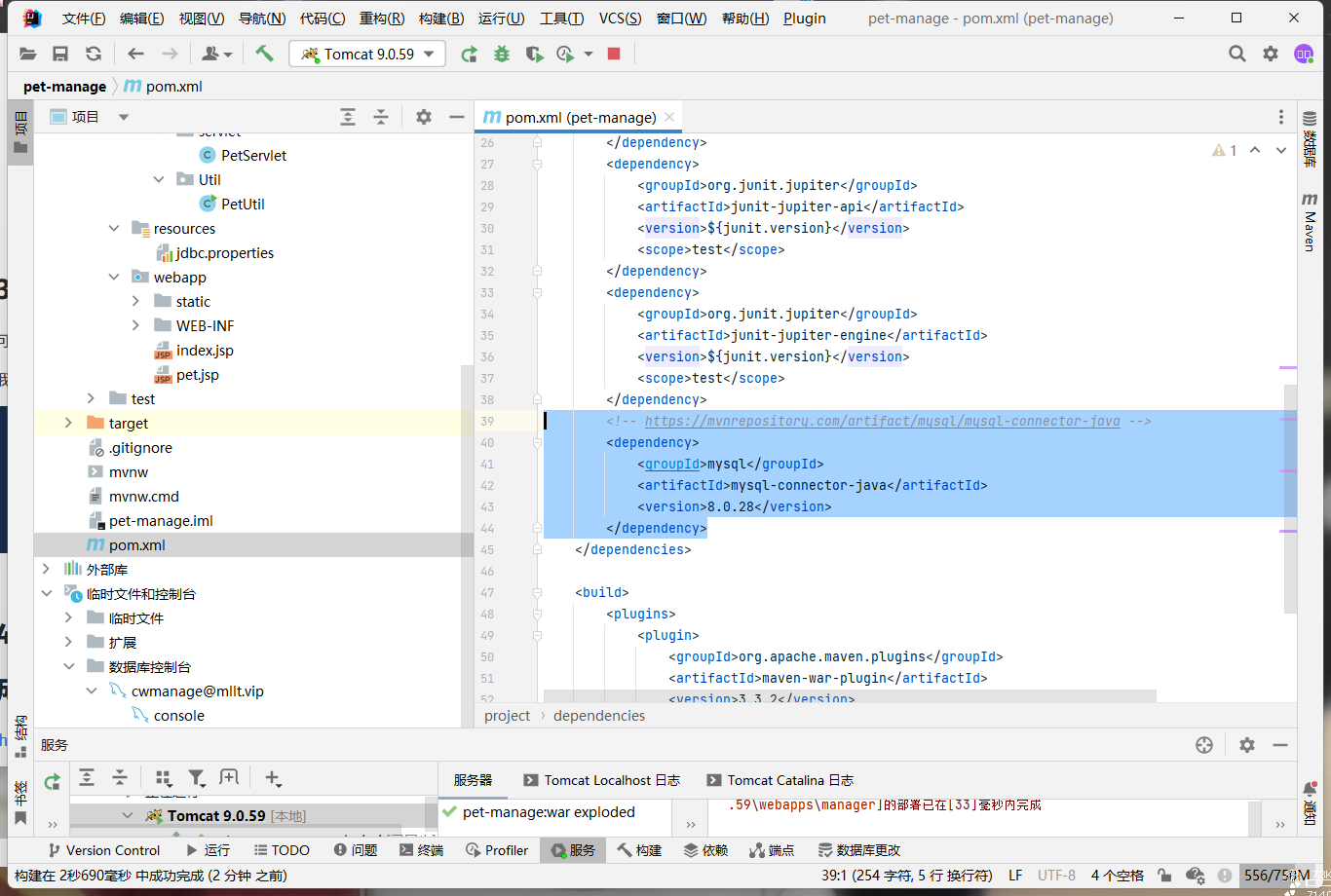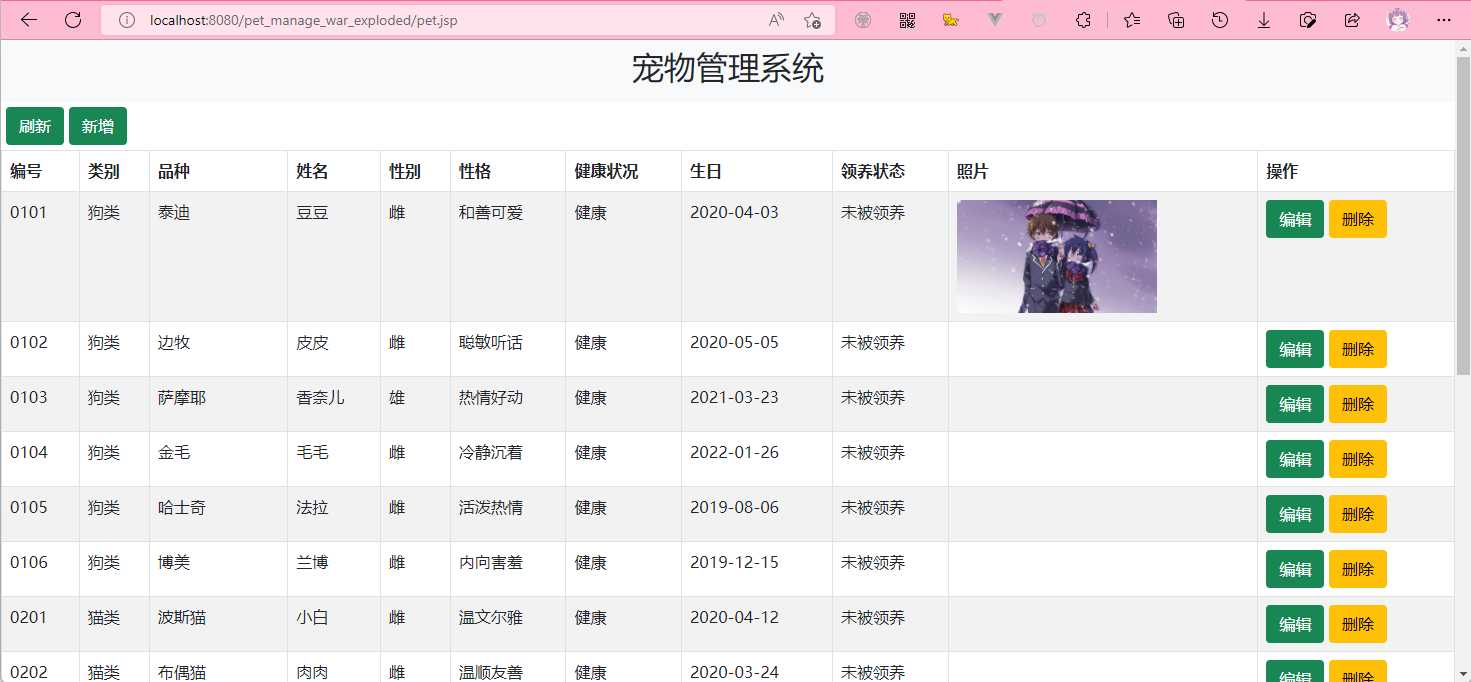【Javaweb】基础开发流程与介绍
本文档写于2022年7月29日,由于个人水平有限,可能存在一些问题,因此仅供参考 @萌狼蓝天
JavaWeb基础开发流程
1.确定系统和功能
在此以“宠物管理系统”为例,要开发一个简单的宠物管理系统,功能如下:
(1)管理员需要通过登陆进入系统
(2)支持宠物信息的增加、查询、修改、删除
2.设计数据库
根据功能,分析应该存在两个数据表:一个用户信息表(此处的用户,指的是系统的使用者,也就是管理员)、一个宠物信息表

3.在IDEA中创建项目,导入所需Jar包
可以手动导入Jar包,如果使用了Maven管理工具的可以编辑pom.xml
我使用的Maven,需要添加
<!-- https://mvnrepository.com/artifact/mysql/mysql-connector-java -->
<dependency>
<groupId>mysql</groupId>
<artifactId>mysql-connector-java</artifactId>
<version>8.0.28</version>
</dependency>

4.使用IDEA自带数据库工具的自带扩展脚本自动生成对象代码
https://www.bilibili.com/video/BV1od4y1m7vh
5.编辑配置文件,连接数据库
(1)在resource下创建jdbc.properties,内容如下
driverClass=com.mysql.cj.jdbc.Driver
jdbcUrl=jdbc:mysql://域名:3306/数据库名?zeroDateTimeBehavior=convertToNull
user=用户名
password=密码
zeroDateTimeBehavior=convertToNull是为了处理Date数据无效时产生的错误,写了这个之后,无效Date数据会自动转为Null
(2)创建JDBC工具类,用于连接数据库
package cc.mllt.jdbc;
import java.sql.*;
import java.util.ResourceBundle;
public class JDBCUtils {
//私有化构造函数
//防止外界直接创建对象
private JDBCUtils(){}
//提供静态方法getConnection
//用来对外提供数据库连接对象
/**
*Connection 用来对外提供数据库连接对象
* @return
*/
public static Connection getConnection(){
try{
//0.读取文件属性
ResourceBundle conf = ResourceBundle.getBundle("jdbc");
//1.注册驱动
Class.forName(conf.getString("driverClass"));
//2.获取数据库连接
String url = conf.getString("jdbcUrl");
String user = conf.getString("user");
String password = conf.getString("password");
Connection conn = DriverManager.getConnection(url,user,password);
return conn;
}catch (Exception e){
e.printStackTrace();
}
return null;
}
//提供静态方法close,用来释放资源
/**
*close 用来释放资源
* @param rs
* @param st
* @param conn
*/
public static void close(ResultSet rs, Statement st,Connection conn){
//关闭结果资源集
if(rs!=null){
//防止空指针异常
try{
rs.close();
}catch (SQLException e){
e.printStackTrace();
}finally {
rs=null;//手动置空,等待GC回收
}
}
//关闭传输器资源
if(st!=null){
//防止空指针异常
try {
st.close();
}catch (SQLException e){
e.printStackTrace();
}finally {
st = null;//手动置空,等待GC回收
}
}
//关闭数据库连接资源
if(conn!=null){
//防止空指针异常
try {
conn.close();
} catch (SQLException e) {
e.printStackTrace();
}finally {
conn=null;//手动置空,等待GC回收
}
}
}
}
6.编写功能模块
在此以查询为例,编写查询数据的代码
/**
* 获取所有宠物信息
* @return List<Pet> 成功返回以宠物对象构成的列表,失败返回null
*/
public static List<Pet> getPetInfo(){
Connection connection = null;
PreparedStatement ps = null;
ResultSet rs =null;
List<Pet> list = new ArrayList<Pet>() {
};
try {
connection = JDBCUtils.getConnection();
String sql = "select * from pet";
ps = connection.prepareStatement(sql);
rs = ps.executeQuery();
while (rs.next()){
Pet pet = new Pet();
pet.setCode(rs.getString(1));
//1对应的是数据表中第一列的数据
pet.setType(rs.getString(2));
//1对应的是数据表中第二列的数据
pet.setName(rs.getString(3));
pet.setKind(rs.getString(4));
pet.setGender(rs.getLong(5));
pet.setCharacter(rs.getString(6));
pet.setHealth(rs.getString(7));
pet.setBirth(rs.getDate(8));
pet.setPic(rs.getString(9));
pet.setState(rs.getLong(10));
list.add(pet);
}
} catch (SQLException e) {
System.out.println(e);
return null;
}
return list;
}
7.编写前端页面
可以先使用HTML写好模板,再迁移入JSP
8.前端获取后端数据并显示
<%@ page import="cc.mllt.Util.PetUtil" %>
<%@ page import="java.util.List" %>
<%@ page import="cc.mllt.dao.Pet" %>
<%@ page contentType="text/html; charset=UTF-8" pageEncoding="UTF-8" %>
<!DOCTYPE html>
<html>
<head>
<title>宠物管理系统</title>
<!-- 新 Bootstrap5 核心 CSS 文件 -->
<link rel="stylesheet" href="https://cdn.staticfile.org/twitter-bootstrap/5.1.1/css/bootstrap.min.css">
<!-- 最新的 Bootstrap5 核心 JavaScript 文件 -->
<script src="https://cdn.staticfile.org/twitter-bootstrap/5.1.1/js/bootstrap.bundle.min.js"></script>
<style>
img{
width:200px;
height: auto;
margin: 0 auto;
}
.control{
margin:5px;
}
</style>
</head>
<body>
<%
List<Pet> pets = PetUtil.getPetInfo();
System.out.println(pets);
%>
<nav class="navbar navbar-expand-sm bg-light justify-content-center">
<h2>宠物管理系统</h2>
</nav>
<div class="control">
<button type="button" class="btn btn-success">刷新</button>
<button type="button" class="btn btn-success">新增</button>
</div>
<table class="table table-striped table-bordered table-hover">
<thead>
<th>编号</th>
<th>类别</th>
<th>品种</th>
<th>姓名</th>
<th>性别</th>
<th>性格</th>
<th>健康状况</th>
<th>生日</th>
<th>领养状态</th>
<th>照片</th>
<th>操作</th>
</thead>
<%
for (Pet pet : pets) {
%>
<tr>
<td><%=pet.getCode()%>
</td>
<td><%=pet.getType()%>
</td>
<td><%=pet.getKind()%>
</td>
<td><%=pet.getName()%>
</td>
<td>
<%
String gender="";
if(pet.getGender()==0){
gender="雌";
}
if(pet.getGender()==1){
gender="雄";
}
if(pet.getGender()==2){
gender="雌雄共同";
}
if(pet.getGender()==3){
gender="雌雄不分";
}
%>
<%=gender%>
</td>
<td><%=pet.getCharacter()%>
</td>
<td><%=pet.getHealth()%>
</td>
<td><%=pet.getBirth()%>
</td>
<td>
<%
String state="";
if(pet.getState()==0){
state="未被领养";
}
if(pet.getState()==1){
state="已被领养";
}
%>
<%=state%>
</td>
<td><img src=<%=pet.getPic()%> >
</td>
<td>
<button type="button" class="btn btn-success">编辑</button>
<button type="button" class="btn btn-warning">删除</button>
</td>
</tr>
<%
}
%>
</table>
</body>
</html>

9.美化前端
可以使用Bootstrap或者自己编写样式美化前端。
10.优化后端代码(逻辑算法等)
版 权 声 明


